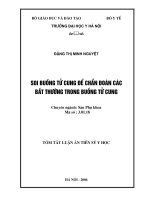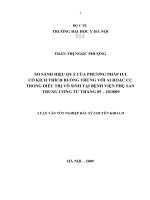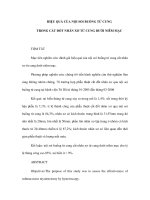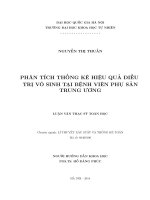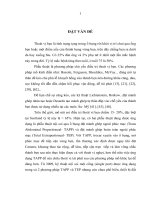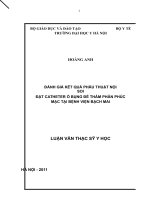Hiệu quả phẫu thuật nội soi ổ bụng và nội soi buồng tử cung trong chẩn đoán và điều trị vô sinh tại BV Sản Nhi Quảng Ninh_Tiếng Anh
Bạn đang xem bản rút gọn của tài liệu. Xem và tải ngay bản đầy đủ của tài liệu tại đây (1.82 MB, 31 trang )
<span class='text_page_counter'>(1)</span><div class='page_container' data-page=1></div>
<span class='text_page_counter'>(2)</span><div class='page_container' data-page=2>
“<b>EFFECTIVENESS OF COMBINED </b>
<b>HYSTEROSCOPY AND LAPAROSCOPY </b>
<b>IN DIAGNOSIS AND TREATMENT OF INFERTILITY IN </b>
<b>QUANG NINH HOSPITAL OF OBSTETRICS AND </b>
<b>PEDIATRICS</b>”
<b> Nguyen Quoc Hung </b>
<b> Tran Thi Minh Ly </b>
<b> Do Duy Long </b>
</div>
<span class='text_page_counter'>(3)</span><div class='page_container' data-page=3>
CONTENT
<b>INTRODUCTION </b>
<b>OBJECTS AND METHOD </b>
<b>DISCUSSION </b>
<b>CONCLUSION </b>
</div>
<span class='text_page_counter'>(4)</span><div class='page_container' data-page=4>
<b>INTRODUCTION </b>
Infertility:
failed to conceive after 12
months of regular sexual intercourse
without the use of contraception
Range from
8% to 15%
Male infertility
40%,
female infertility
40%,
20%
no cause is found
Primary and secondary infertility
</div>
<span class='text_page_counter'>(5)</span><div class='page_container' data-page=5></div>
<span class='text_page_counter'>(6)</span><div class='page_container' data-page=6>
Hysteroscopy
Polyps and adhesions, anomalies of uterin cavity
Laparoscopy
Investigations, diagnosis of pelvic diseases
Fibroids, uterine malformation
Ovarian tumor
<sub> Fallopian </sub> <sub>tube: </sub> <sub>hydrosalpinx, </sub> <sub>pyosalpinx, </sub>
salpingitis, obstruction...
<sub> Endometriosis </sub>
</div>
<span class='text_page_counter'>(7)</span><div class='page_container' data-page=7>
<b>PURPOSE </b>
To
evaluate
the
effectiveness
of
</div>
<span class='text_page_counter'>(8)</span><div class='page_container' data-page=8></div>
<span class='text_page_counter'>(9)</span><div class='page_container' data-page=9>
<b>OBJECTS </b>
Prospective cohort Study
All infertile patients with indication for
hysterolaparoscopy
at
Quang
Ninh
Hospital of Obstetrics and Pediatrics
</div>
<span class='text_page_counter'>(10)</span><div class='page_container' data-page=10>
<b>METHOD</b>
Step 1: Medical records. All patients
participating in the research had
Hysterosalpingogrphy before and after surgery
Step 2: Surgery<b> </b>
</div>
<span class='text_page_counter'>(11)</span><div class='page_container' data-page=11>
90 patients
Primary infertility accounts for 59.2%.
Secondary infertility accounts for 40.8%.
Mean age (all) 34.7; primary infertility
group: 32.8; secondary infertility group 35.9
</div>
<span class='text_page_counter'>(12)</span><div class='page_container' data-page=12>
<b>Number of </b>
<b>abortions </b>
<b>0 </b>
<b>1 </b>
<b>2 </b>
<b>3 Total </b>
<b>n </b>
1
71
15
3
90
<b>% </b>
1.1 78.9 16.7 3.3 100
<i>Table 1. Distribution of patients based on previous abortions</i>
</div>
<span class='text_page_counter'>(13)</span><div class='page_container' data-page=13>
<i>Table 2: Comparision of HSG and endoscopy </i>
<b> RESULTS </b>
<b> </b>
<b> </b>
<b>Endo. fits HSG </b> <b>Endo. not fits HSG </b> <b>Total </b>
<b>Normal HSG </b>
16
4
20
<b>Abnormal HSG </b>
58
12
70
<b>Total </b>
74
16
90
</div>
<span class='text_page_counter'>(14)</span><div class='page_container' data-page=14>
<b>RESULTS </b>
<b>Pathology </b> <b>n </b> <b>% </b>
<b>Fallopian tube pathology </b> 65 72.2
<b>Endometrial polyps </b> 10 11.1
<b>Fibroids </b> 5 5.6
<b>Endometriosis </b> 10 11.1
<b>Adhesion </b> 20 22.2
</div>
<span class='text_page_counter'>(15)</span><div class='page_container' data-page=15>
<i>Table 4. Effectiveness of laparoscopy </i>
<b>RESULTS </b>
<b>Before surgery </b>
<b>After surgery </b>
<b>2 obstructed </b>
<b>fallopian tubes </b>
<b> 1 passable </b>
<b>fallopian tube </b>
<b> 2 passable </b>
<b>fallopian tubes </b>
<b>Obstruction of 1 </b>
<b>fallopian tube </b> <b>16 </b> <b>0 </b> <b>5 </b> <b>11 </b>
<b>Obstruction of 2 </b>
<b>fallopian tubes </b> <b>49 </b> <b>6 </b> <b>18 </b> <b>25 </b>
<b>Total </b> <b><sub>65 </sub></b> <b><sub>6 </sub></b> <b><sub>23 </sub></b> <b><sub>36 </sub></b>
</div>
<span class='text_page_counter'>(16)</span><div class='page_container' data-page=16>
<b>RESULTS </b>
</div>
<span class='text_page_counter'>(17)</span><div class='page_container' data-page=17>
Duration < 5 days 5-7 days > 7 days
<b>n</b> 83 7 0
<b>%</b> 92,2 7,8 0
<i>Table 5. Mean duration of hospitalization </i>
<b>RESULTS </b>
</div>
<span class='text_page_counter'>(18)</span><div class='page_container' data-page=18>
<i>Chart 2. Pregnancy rate after treatment </i>
</div>
<span class='text_page_counter'>(19)</span><div class='page_container' data-page=19>
46
10 <sub>5</sub>
12
5 <sub>12</sub>
0
10
20
30
40
50
60
70
<b>Spontaneous</b> <b>IUI</b> <b>IVF</b>
<b>#</b>
<b> o</b>
<b>f </b>
<b>p</b>
<b>a</b>
<b>ti</b>
<b>en</b>
<b>ts</b>
<b>Pregnant</b>
<i>Chart 3. Cumulative pregnancy rate </i>
<b>RESULTS </b>
<b>No. </b>
<b>of </b>
</div>
<span class='text_page_counter'>(20)</span><div class='page_container' data-page=20>
<b>DISCUSSION </b>
Fallopian tubes obstruction through laparoscopy.
Fallopian tubes obstruction accounts for 72.2%.
16 cases have 1 blocked fallopian tube, 49 cases
have 2 blocked fallopian tubes.
Nguyen Viet Tien, 2010: (54,3%).
Pham Nhu Thao, 2003: (58,6 %).
1. Nguyễn Viết Tiến (2013), <i>Các quy trình chẩn đốn và điều trị vơ sinh</i>, Nhà xuất bản Y học.
</div>
<span class='text_page_counter'>(21)</span><div class='page_container' data-page=21>
<b>DISCUSSION </b>
<i> Uterus pathology</i>
5 patients with fibroids, accounting for 5.6%.
All myomectomy is performed via hysteroscopy,
there is no open surgery.
<i>Endometriosis </i>
Endometriosis
</div>
<span class='text_page_counter'>(22)</span><div class='page_container' data-page=22>
<b>Endometrial polyps and adhesion</b>
Abnormal HSG 33%.
Endometrial polyps: 11.1%,
lower than Moravek
(15.3%) and higher than
Dreisler (7.8%).
Most cases primary
infertility found among
patiens with uterine
adhesion, history of
abortions, curretage
<b>DISCUSSION </b>
1. Moravek M., Will M., Clark N., et al. (2011). Prevalence of Endometrial Polyp in Reproductive-Age Infertile Women. Fertil Steril, 95(4), S24–S25.
</div>
<span class='text_page_counter'>(23)</span><div class='page_container' data-page=23>
Value of HSG and hysteroscopy
HSG has a sensitivity of 93.5%, specificity of
57.1%.
False negative - false positive rates: 20% -
17.1% (LaSala: 26% - 10%, Otubus: 30.4% -
25%, Hourvitz: 12% - 19%).
HSG in agreement with hysterolaparoscopy
in 82% (Kaya Vaid: 66,3%)
<b>DISCUSSION </b>
1. La Sala G.B., Sacchetti F., Degl’Incerti-Tocci F., et al. (1987). Complementary use of hysterosalpingography, hysteroscopy and laparoscopy in 100 infertile patients: results and comparison of their
diagnostic accuracy. <i>Acta Eur Fertil</i>, <b>18</b>(<b>6</b>), 369–374.
2. Otubu J.A., Sagay A.S., and Dauda S. (1990). Hysterosalpingogram, laparoscopy and hysteroscopy in the assessment of the infertile Nigerian female. <i>East Afr Med J</i>, <b>67</b>(<b>5</b>), 370–372.
3. Hourvitz A., Lédée N., Gervaise A., et al. (2002). Should diagnostic hysteroscopy be a routine procedure during diagnostic laparoscopy in women with normal hysterosalpingography?. <i>Reprod </i>
<i>Biomed Online</i>, <b>4</b>(<b>3</b>), 256–260.
</div>
<span class='text_page_counter'>(24)</span><div class='page_container' data-page=24>
Cumulative pregnancy rate after surgery
Till the end of November 2016, the average
postoperative follow-up time for all patients is 10.2
months.
Cumulative pregnancy rate is 32.2%, 12 patients get
pregnant spontaneously, 5 patients get pregnant after
IUI and 12 patients get pregnant after IVF.
</div>
<span class='text_page_counter'>(25)</span><div class='page_container' data-page=25>
The most common cause of infertility is fallopian
pathology, accounting for 72.2%, followed by
endomentrial adhesion with 22.2%.
18% of patients with HSG are not homologous
with hysterolaparoscopy.
After surgery, all patients with endometrial
adhesion have completely recovery and 68%
patients has at least 1 passagable fallopian tube,
the cumulative pregnancy is 32% and no
complication has been recorded
</div>
<span class='text_page_counter'>(26)</span><div class='page_container' data-page=26>
<b>STEP 1. PREPARATION </b>
Doctor: Obstetrician
Equipment: required equipment for
hysterolaparoscopy
Medical record as formed
Place: Operating room
Patients
Take general and specialist health check.
Be consulted about surgery risks and complications
Take HSG to identify lesions
Take misoprostol for cervical ripening
</div>
<span class='text_page_counter'>(27)</span><div class='page_container' data-page=27>
<b>PROTOCOL </b>
<b>STEP 2: SURGERY </b>
<i>2.1. Hysteroscopy </i>
Spinal anesthesia or general anesthesia
Sterilization
Put vaginal valve, clamp the cervix.
Measure the uterine and dilate the cervix.
Set up hysteroscopic machine.
Pump sorbitol 3% into uterine cavity.
</div>
<span class='text_page_counter'>(28)</span><div class='page_container' data-page=28>
<b>PROTOCOL </b>
<b>STEP 2: SURGERY </b>
<i>2.2. Laparoscopy </i>
Set up trocart and pump CO2
Put in camera for checking abdominal cavity
Remove adhesion, open hydrosalpix and
reconstruction fimbria….
Pump methylene green.
</div>
<span class='text_page_counter'>(29)</span><div class='page_container' data-page=29>
<b>Step 3. Follow-up after surgery</b>
Put intrauterine contraceptive device and use artifical
menstration in patient with uterine pathology
Perform ultrasound and HSG after 1 month to evaluate
the results.
Consult patients to take IUI or IVF or natural cycles
<b>Step 4. Deal with complications</b>
Bleeding
Uterine perforation
Circulatory overload due to pumping fluid into uterine.
Infection
</div>
<span class='text_page_counter'>(30)</span><div class='page_container' data-page=30></div>
<span class='text_page_counter'>(31)</span><div class='page_container' data-page=31></div>
<!--links-->
